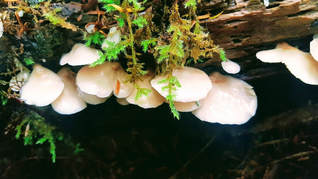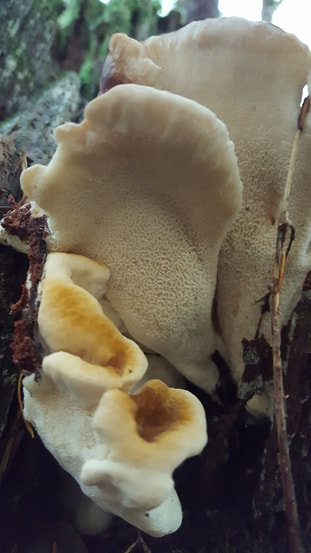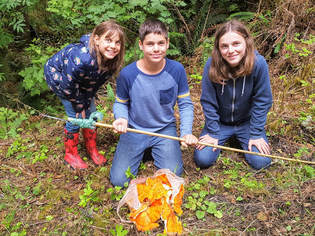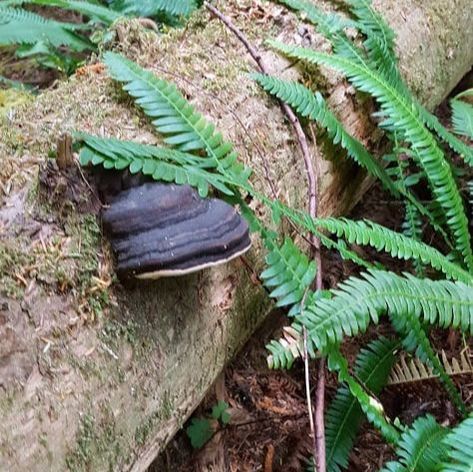We love Mushrooms!
Our region has a diverse variety of mushrooms and Josh, Emma and Wyatt love to hunt for them! This page is for show and tell, and a little education!
Ewwww. Fungus.
Every time I say that we eat wild mushrooms, I get one of two responses. People either say, "EEEEEWWW! I hate mushrooms!!" or "aren't you afraid you will eat poisonous mushrooms and die?" For the first, I have to sadly agree. I also don't particularly care for mushrooms.
But every year I choke them down by the dozen.
Did you know that mushrooms are closer in their genetic make up to humans than plants? I don't know what that means on a spiritual/philosophical level, but from a nutritional stand point, it means that mushrooms are powerhouses of nutrients for our bodies. Mushrooms are high in the B vitamins. They also are high in vitamin D (something we in the PNW could always use a little more of), zinc, selenium and many other awesome immune supporting vitamins. But this is just the start of the positive effects mushrooms can have on our health.
If you are someone who subscribes to the "like heals like" theory of plant medicine, it will come as no surprise to you that mushrooms are awesome for our brains and nerves. As such, many healing traditions like TCM and Ayurveda use mushrooms in the healing of painful inflammatory conditions and nerve degeneration conditions. There is also some indication that some mushrooms help ward off cancer, improve symptoms in people suffering from memory loss, and help heal skin wounds quicker. For instance, the ancient Chinese considered Rishi "the mushroom of Immortality", and was used by the wealthy for healing of ailments and increasing longevity.
As for the poisonous mushrooms, there is no room for error, so we do not ingest any mushrooms we do not have a 100% positive ID for. Read here for some resources I recommend for ID'ing mushrooms. We have passed up many mushrooms because we could not make an 100% sure ID.
But every year I choke them down by the dozen.
Did you know that mushrooms are closer in their genetic make up to humans than plants? I don't know what that means on a spiritual/philosophical level, but from a nutritional stand point, it means that mushrooms are powerhouses of nutrients for our bodies. Mushrooms are high in the B vitamins. They also are high in vitamin D (something we in the PNW could always use a little more of), zinc, selenium and many other awesome immune supporting vitamins. But this is just the start of the positive effects mushrooms can have on our health.
If you are someone who subscribes to the "like heals like" theory of plant medicine, it will come as no surprise to you that mushrooms are awesome for our brains and nerves. As such, many healing traditions like TCM and Ayurveda use mushrooms in the healing of painful inflammatory conditions and nerve degeneration conditions. There is also some indication that some mushrooms help ward off cancer, improve symptoms in people suffering from memory loss, and help heal skin wounds quicker. For instance, the ancient Chinese considered Rishi "the mushroom of Immortality", and was used by the wealthy for healing of ailments and increasing longevity.
As for the poisonous mushrooms, there is no room for error, so we do not ingest any mushrooms we do not have a 100% positive ID for. Read here for some resources I recommend for ID'ing mushrooms. We have passed up many mushrooms because we could not make an 100% sure ID.
Edible Wild Mushrooms
Chantrelles (Cantharellus cibarius)
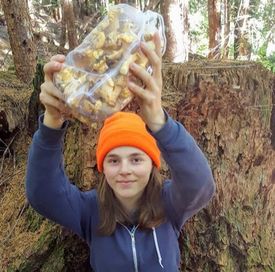
Every year we go hunting in the fall for Chantrelles. These mushrooms grow in both mountain ranges on either side of the valley we live in. Chantrelles are a staple of our diet in the fall months, and we freeze or dry them to add to soups and stir fries through the winter although they are never quite as tasty as when fresh. Chantrelles are easy to identify. All our kids are expert at spotting them. There is a common look alike but it has gills and the stem is hollow as opposed to the Chantrelle which has ridges that extend down the stem, and the stem is not hollow. We sort through the kid's bags at the end of the day to make sure there were no "oops", but so far they have done well. Be aware that some forest areas have limits on how many Chantrelles you can harvest, and in some areas there are even permits needed.
Read about our latest Chantrelle trip here.
Read about our latest Chantrelle trip here.
Chicken of the Woods(Laetiporus Sulphureus)
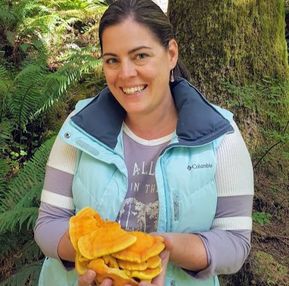
If you are like me and fungus is not your favorite, then you will be excited to know that there is a forest fungus that the eating experience is not totally like chewing on someone else's tongue. On our 15 year aniversary trip, Josh and I went up into the woods to look for early fall mushrooms. We do this most years, but this year we found some sweet Chicken of the Woods specimens. A lot of times you can only eat the outer edges of Chicken of the Woods as they get really tough. This one was freshly bloomed, and the shelves were really tender, springy without being too chewy. We added it to more than one stir fry and I chopped some. Saute'd in butter, garlic and onions, it was added to our scrambled free range eggs for a super nutritious start to the day!
Morel (Morchella esculentoides)
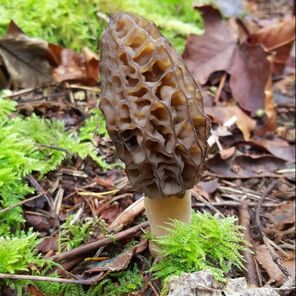
Spring is always busy for us, so we have not been as lucky finding time to go hunt for these beauties. Never the less, the few times we have been able to get away, we have been thrilled with these guys. Morels are tasty and all the more so because they are not a cultivated mushroom, only growing in the wild. Morel mushrooms grow best in new growth-clear cuts, areas that have been renewed by fire, etc. There are a few look alikes, so make sure you know for sure before eating!
Rishi (Ganoderma Orgonense)
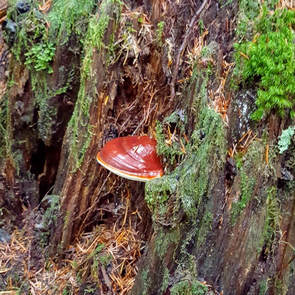
Occaisionally, we find some Oregon Rishi. This is such an interesting fungus because it really doesn't have much in the way of culinary uses, but the eastern variety has been used powerfully for 1000's of years for health and wellness. I love that we live in a region that has this powerful medicine! I dried some, and will try my hand at tincturing it. I will eventually do some posts about Rishi and some of the other traditional really awesome mushrooms and their health benefits!
Beautiful Mushrooms that we don't eat
Angel Wings (Pleurocygella Porrigens)
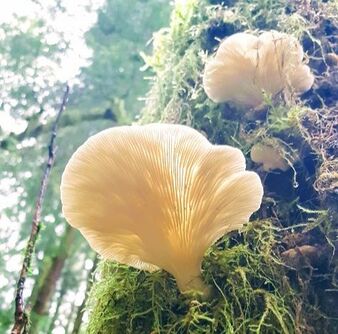
Josh snapped this gorgeous picture of some Angel Wings. They were long considered edible, and I bet scads of people still do eat them, but there is some recent data coming out of Japan potentially linking them to a few cases of brain damage, kidney damage and even death. So, since we like our brains and kidneys, we choose to admire their beauty and pass them by without sampling just to be on the safe side. If you want to eat them, I would recommend doing your own research first.

